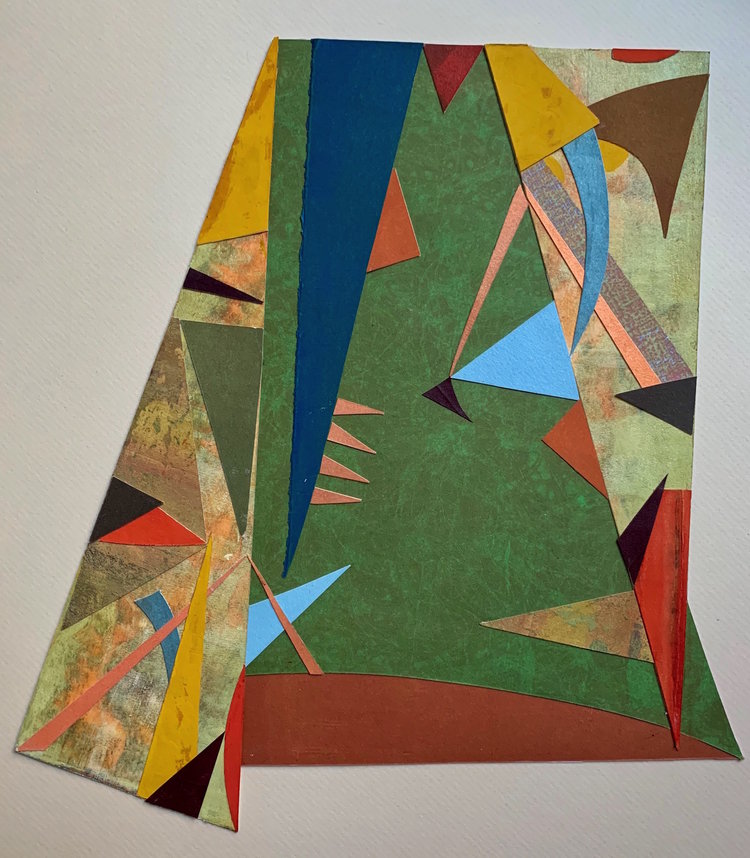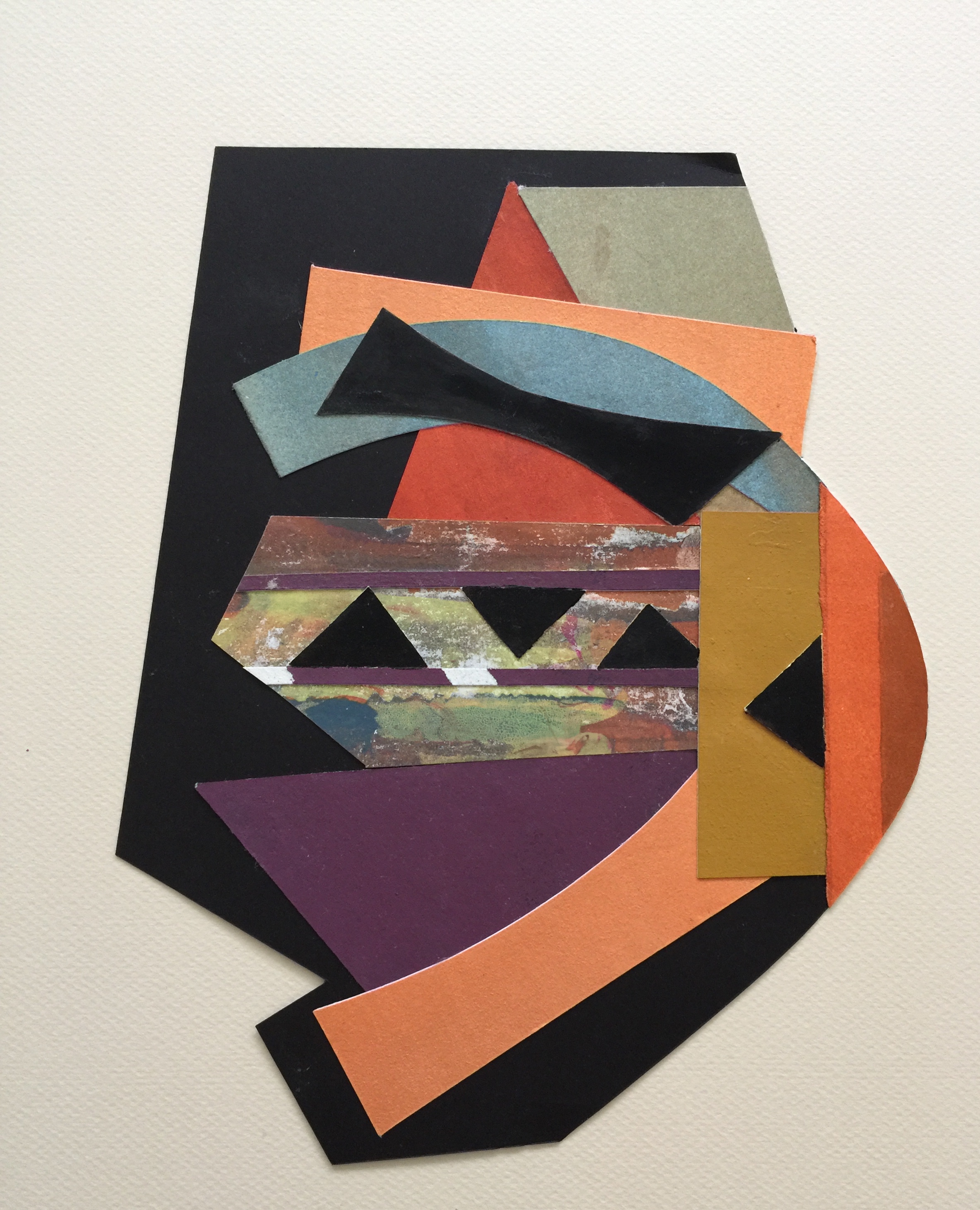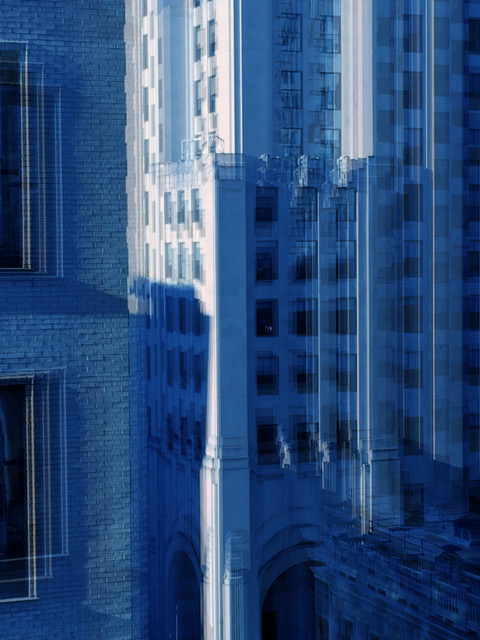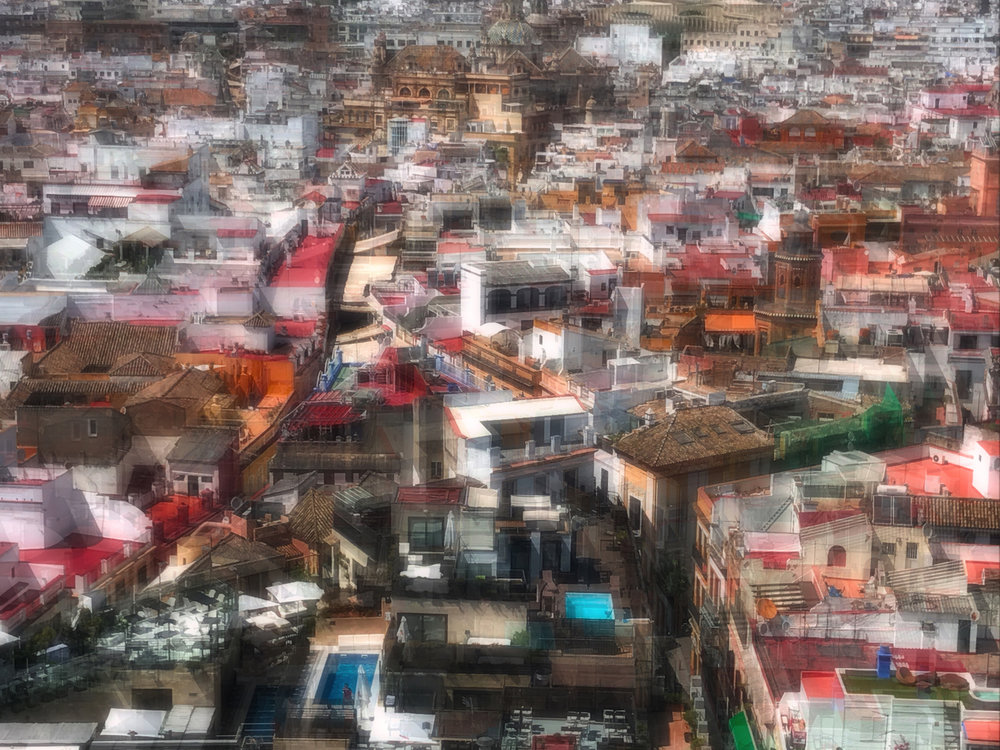September in the Annex: Shazia Fahim, Ruth LaGue, and Meghan Mirasolo
Rapid movement, interior universes and the energy of color come together in an exhibition featuring artists Shazia Fahim, Ruth LaGue, and Meghan Mirasolo. September’s Annex exhibit is about finding directions through the landscape and pattern and with the use of photography, painting, printmaking and collage these three artists reflect a state of wonder of the known and unknown realities of life.
In this post the artists share how they came to create, what inspires them, and their work.
Shazia Fahim
I have always been enamored by colors. We are all surrounded by the energy of colors. I derive energy from this creative process, which is akin to a meditative experience for me. I interpret the journey of the soul by playing intuitively with colors and shapes.
My interest in mixed media collages emerged after getting introduced to printmaking at the Massachusetts College of Art and Design. I learned different techniques of printmaking, and as different patterns and textures began to appear on sheets of paper with rich colors of oil based inks, my curiosity kept on increasing. I have always been enamored by colors. Printmaking allowed me to grow beyond my perceived limits and gave me the freedom to let go of myself.





Once a large variety of colors, patterns and textures were produced, I would divide them in different color categories and lay all of them. I would start combining colors intuitively and cut different shapes and start putting the collages together. There is a lot of arranging and rearranging that goes into the process before deciding on the final piece. It’s like putting a puzzle together with many different answers. I really enjoy the element of surprise in the printing process as well as in the process of making collages. I also add mixed media to the final piece as well to provide the integrative statement.
Ruth LaGue
I was raised in Alaska – the last frontier. Where it’s dark 6 months and light 6 months of the year. My sister and I were raised by our parents, who had two principles; #1 kids must be outside, and #2 it’s a parents responsibility to give their kids a strong foundation in spirit; to our parents these two things were at the foundation of being a strong and good citizen of this world.
As you can imagine, my sister and I spent an enormous amount of time outside (with and without my parents), fishing, canoeing, skiing, hiking, snowmobiling – you name it.
My Dad, a man of million anecdotes, had one in particular he would tell us almost every time we’d go walking in the woods with him; it would go something like this, “hey girls, how far can you go into the woods” – I don’t know Dad, how far? "Half way, because the other half you’re going out".
Now my Dad wasn’t always a big joker, he also taught me some pretty particular things about nature like; in the northern hemisphere, moss grows on the north side of trees, in case you get lost in the woods, you know where north is. When you’re crossing a swift river, don’t look down just look forward, this way you won’t lose your footing and fall. And lastly, maybe most important of all, always be keenly aware of your surroundings; bears smell like garbage, if you smell that, get the heck out of there.
You could say, that Alaska galvanized my love of landscapes – it’s wide-open spaces, big skies and never ending mountain ranges. There was always something new to see, no matter where you were; the outdoors was a rich treasure of sights, sounds, and stillness.




Fast forward to my late twenties – I had just graduated from art school, gotten my first job here in Boston (as a on-air graphic designer for channel 7). The dust had finally settled and I was beginning a new start in a big city. Yet, I was consumed with an overwhelming feeling that I was missing something.
I told a friend about my dilemma and he suggested meditation. He suggested I travel with him to the Catskills to meet his meditation teacher. I went and was hooked. There was the stillness I had experienced in nature but there was also the connection to spirit that I had lost since being away from my home. I have continued to practice meditation in one form or another for the last 30 years.
It wasn’t until about 15 years ago, that I began to feel that my creativity needed another outlet; graphic design wasn’t cutting it. I took a class in encaustic painting (painting with beeswax) and again had that familiar feeling of stillness returned. I later went from encaustic painting to painting with acrylics.
What I like about both mediums is the textures I can create through the use of brushes and palette knives – and the effects I get from layering thick layers of paint on the canvas or board. My subject has always been the landscape. I’ve tried other things, but my true passion lies in the land.
My work will often be a mixture of real and made-up scenes. I take a number of photographs of sunrises, sunsets, hills, beaches and trees. I’m often inspired by photos taken by friends or other professionals and will combine these with scenes from my childhood.
I carry a sketchbook with me to capture images I’ve seen – my sketches are rough only indicating colors, patterns, or shapes – so I have something to refer to when I’m working back in my studio. I will rough out shapes on my canvas. That’s not to say I follow those drawings or lines exactly. It’s an organic process.
It wasn’t until recently that I began to understand that painting and meditation were quite similar. I’ve noticed that I perform similar rituals when preparing to do both. I find a quiet room to work in, prepare my surroundings, center myself and ease into my work. Neither happens spontaneously. Establishing a quiet space both inside and out is key.
This quiet space is what Buddhist call COOL BOREDOM. It’s where not much is happening in the mind, so you can work with what is arising in the present moment.
Alice Walker has said she isn’t a meditator but the act of writing – every time she writes, is a practice of meditation.
Let’s try an experiment. – are you up for it? Great! OK let’s sit up straight, get comfortable, unfold your hands, put them your lap, you can close your eyes if you’d like. Now take a deep breath in through your nose and exhale through your mouth, again, inhale through your nose and exhale slowly through your mouth – one more time. This is he process of slowing down your mind, allowing our selves to be open to possibilities and readying ourselves for the work ahead.
Now let’s take a minute while we’re in this state and observe the work in front of us. When observing art I think it’s important to ask yourself two questions.
1. What do you notice about the artwork and
2. How are you feeling today.
If you’re not in touch with where you are at the moment it makes it hard to really see the work in front of you.
It can go something like this – start by listing the attributes of the work what you literally see, then you look keep deeper and closer, noticing the subtleties of the work.
Scientists tell us that mirror neurons are neurons that fire both when a person acts and when a person observes. When you observe a piece of art that profoundly moves you, you are firing the same neuron as the artist that created it – making a new neural pathway and stimulating inspiration. This connection point is called “EMBODIED COGNITION”
I like to think of it like this – at the moment of inspiration, you and the artist are one, and you share the same spark. Think about that for a moment. You now have a direct link to that inspirational experience and you can call upon it at any moment you choose and create whatever you want. That’s awesome.
So today you’ve participated in observation and reflection and you didn’t have to be on the lookout for smelly bears, cross swift streams or walk halfway through the woods to do it.
You practiced quieting your mind, and you experienced what’s at the heart of creativity, no matter what the subject is – art is a shared experience between the subject, the artist and the observer.
Meghan Mirasolo
I’m a bit restless by nature. Routine and monotony tend to get to me after awhile. I find travel is the perfect remedy. As soon as time and money permit, I’m out the door looking for an adventure. I want to see as much as possible before I have to return to “everyday” life. To document my travels, I take A LOT of photos. My photography is just as restless as I am. I’m definitely guilty of not slowing down and being in the moment. I pass through places quickly, looking through my lens. What’s next? What else can I see?
When I get home, I have a chance to stop and look at the photos. I notice details and moments that I maybe missed the first time around. I think about the Edward Weston quote, “Why limit yourself to what your eyes see when you have an opportunity to extend your vision?” Next, I use Photoshop to layer certain photos on top of each other, letting moments play out. I manipulate the opacity so all the photos can be seen at once.It is almost like time lapse photography, except my photos were taken over the course of seconds or minutes, not hours or days.
The finished artwork tries to capture the feeling of rapidly moving from one place to another, of new and unfamiliar locales becoming the new norm, if only for a moment. They convey a sensation of space subtly shifting. The layered images create a fragmented atmosphere. Everything feels so ordinary, but is slightly off. I’m looking to see the unseen in structures and landscapes, to capture missing moments.



In many ways, I think my work is a reflection of our modern age. The world feels very small and almost too accessible. It is easy to move about quickly, to continually change locations and wake up in new settings. For better or worse, cheap airfare and Airbnb have made the seeing the world almost too convenient. It has changed the way I explore and the way I photograph. Slowing down and looking is what creating my artwork forces me to do. I hope it does the same for viewers. We can all look a little closer at a passing vista or a moment that initially slipped away.
